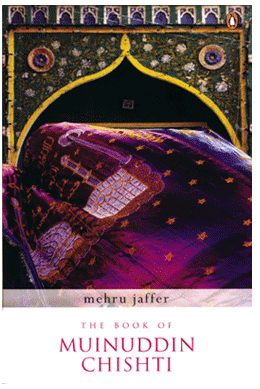- There's room, enough room for change, always...
- Guest Editor’s Column
- Nandan Mela
- Shifting Trends
- Hollywood Regency Furniture
- Hard Talk
- The other side
- Market Insight
- Artist Index and Statistics
- Auction Reports
- Creative Impulse
- Theatre Review
- Love and Hate Spinning a Touchy Tale of Identification
- The winning qustient : SRK or AMIR?
- In the News
- Book Review
- The month that was
- East City Kolkata: Before the campaign
- Stains on my Chintz
- Rythmic Significance
- Logged
- A retrospective and a requiem
- Size matters or does It?
- S.H. Raza
- Malevich matters and other shutters
- B-Swarga
- Black Candy
- Tryst with modernity & tradition
- Simultaneous release of magazines
- Photo Feature
- Different hues of Aakriti
ART news & views
Book Review
Volume: 2 Issue No: 2 Month: 3 Year: 2010
Muinuddin Chishti by Mehru Jaffer
Penguin Books
Historically, Islam's normative vision of society and piety was mediated to the masses in large part by Sufi sheikhs, heirs to Islam's rich mystical tradition. Sufis regarded mysticism as way of life rather than as a separate religion. Anthropologists and scholars have examined the social roles played by the Sufis in some contemporary societies and earlier periods and explored why certain kind of Sufis appeared in the subcontinent when they did and how Sufis of various social types interacted with the main components of the society in which they lived- the upholders of Islamic orthodoxy, the court, and the non- Muslim population- but also how these types evolved and changed over time. For the popular veneration of the Sufis, and more importantly their tombs, has led to the rise of countless popular stories about them that, with the compilation of these biographies passed from oral to written traditions. Considering factors like time lag between the life of Sufi and the date of compilation of his biography led to the confirmation  of certain archetypes of Indo-Muslim saints.
of certain archetypes of Indo-Muslim saints.
Mehru Jaffer's poignant prose 'The Book of Muinuddin Chishti', introduces one of the charismatic personalities of South Asia Muinuddin Chishti, a leader of the premier Chishtiyya order in the subcontinent, to the reader who was born around AD 1141 in Sistan of Iran's Khorasan province. Muinuddin traced his descent from on his mother's side from Hasan, and on his father's side from Husain, the grandsons of Prophet Muhammad. His ancestors for several generations were reputed to be mystics, for these reason his own inclination towards mysticism, signs of which appeared in his early life, might said to be hereditary. The Chishti Sufi order was originally founded in Central Asia and Muinuddin was the first one to introduce its way of life in India, where he lived for four decades and died in 1236. His disciples, Qutubuddin Bakhtiar Kaki, Baba Farid Ganj Shakr, Mubarak Hamiduddin Nagauri, Nizamuddin Auliya and Khwaja Nasiruddin Chiragh later spread out into different parts of the subcontinent and spent their lives spreading the message of spiritual love and brotherhood. In this book Jaffer provides an account of the saint's legacy and spiritual quest that displays spiritual history at its best. She brings alive the story of saint's life, from his days in Nishapur where he met a stranger in his orchard, which he inherited after his father's death, a meeting that enlightened him to renounce the materialistic world, his travels to Baghdad, Samarkand, Bukhara, Damascus, Cairo and Lahore to his final arrival in India, his meeting with Bibi and ultimately becoming Baba Garib Nawaz of the people, Jaffer judiciously shift from fact to fiction, through careful critical reading of available texts and finally the spiritual victory of Chishti over Ajmer which she admits interest her the most.
The great saint wandered into India just before the formation of Slave Dynasty in search of the elusive mystery of the self because he had heard that Hindu philosophy encouraged meditation on the nature of the cosmos and creation. He chose not to battle over God but to practice and spread God's love. “The foundations of Muinuddin, Jaffer writes, are crumbling. It is time to cement this love, to reach out, and wait for the magic of the merciful unfold before us like it had for Muinuddin.”
In the current milieu debate rages over whether politics and religion can ever be fully separate and how identities exist, this book comes as a great respite and transforms us within these realms. A must read for students and scholars of medieval Indian History, religious studies, and Sufism, as well as the general reader.
Nanak Ganguly